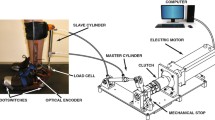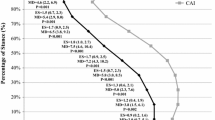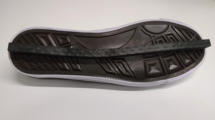Abstract
Purpose
The risk of recurrent ankle sprains could be reduced if the ankle joint is positioned in a more closed pack position (eversion and dorsiflexion) with enhanced co-activation of Tibialis Anterior (TA) and Peroneus Longus (PL) around heel contact in walking. We examined whether such alteration can be induced by augmenting ankle position error in the inversion and plantarflexion directions.
Methods
Fifteen young, healthy subjects participated in this study. They walked on a treadmill while a light weight was affixed to the dorsal–lateral side of the test foot to create afferent error signals in the inversion and plantarflexion directions. We recorded and analyzed subjects’ ankle kinematics and electromyographic (EMG) activity of TA and PL before (baseline), during (adaptation), and after (post adaptation) walking with the weight. Our analyses focused on 30 ms before and after heel contact where ankle sprains are most likely to occur.
Results
Subjects increased ankle eversion before and after heel contact during the adaptation period. This increase carried over to the post adaptation period following removal of the weight. The weight also induced an increase in the TA activity before heel contact during late adaptation, although this increase did not carry over to the post adaptation period. No significant changes were observed in ankle dorsiflexion, PL activity, and muscle co-activation.
Conclusion
Our error-driven approach is feasible to reduce ankle inversion around heel contact in walking, and may have clinical implication on intervention of recurrent ankle sprains.






Similar content being viewed by others
Abbreviations
- TA:
-
Tibialis anterior
- PL:
-
Peroneus longus
- EMG:
-
Electromyography
- LMM:
-
Linear mixed model
- CNS:
-
Central nervous system
- CCI:
-
Co-contraction index
- QTM:
-
Qualisys track manager
- IEMG:
-
Integrated electromyography
References
Blanchette A, Bouyer LJ (2009) Timing-specific transfer of adapted muscle activity after walking in an elastic force field. J Neurophysiol 102:568–577
Blanchette A, Lambert S, Richards CL, Bouyer LJ (2011) Walking while resisting a perturbation: effects on ankle dorsiflexor activation during swing and potential for rehabilitation. Gait Posture 34:358–363
Blanchette AK, Noel M, Richards CL, Nadeau S, Bouyer LJ (2014) Modifications in ankle dorsiflexor activation by applying a torque perturbation during walking in persons post-stroke: a case series. J Neuroeng Rehabil 11:98-0003-11-98
Caulfield B, Crammond T, O’Sullivan A, Reynolds S, Ward T (2004) Altered ankle-muscle activation during jump landing in participants with functional instability of the ankle joint. J Sport Rehab 13:120–189
Collins TD, Ghoussayni SN, Ewins DJ, Kent JA (2009) A six degrees-of-freedom marker set for gait analysis: repeatability and comparison with a modified Helen Hayes set. Gait Posture 30:173–180
Coughlan G, Caulfield B (2007) A 4-week neuromuscular training program and gait patterns at the ankle joint. J Athl Train 42:51–59
Delahunt E, Monaghan K, Caulfield B (2006) Altered neuromuscular control and ankle joint kinematics during walking in subjects with functional instability of the ankle joint. Am J Sports Med 34:1970–1976
Dundas MA, Gutierrez GM, Pozzi F (2014) Neuromuscular control during stepping down in continuous gait in individuals with and without ankle instability. J Sports Sci 32:926–933
Emken JL, Reinkensmeyer DJ (2005) Robot-enhanced motor learning: accelerating internal model formation during locomotion by transient dynamic amplification. IEEE Trans Neural Syst Rehabil Eng 13:33–39
Ferran NA, Maffulli N (2006) Epidemiology of sprains of the lateral ankle ligament complex. Foot Ankle Clin 11:659–662
Garrick JG (1977) The frequency of injury, mechanism of injury, and epidemiology of ankle sprains. Am J Sports Med 5:241–242
Gordon KE, Wu M, Kahn JH, Schmit BD (2010) Feedback and feedforward locomotor adaptations to ankle-foot load in people with incomplete spinal cord injury. J Neurophysiol 104:1325–1338
Gutierrez GM, Kaminski TW, Douex AT (2009) Neuromuscular control and ankle instability. PM R 1:359–365
Gutierrez GM, Knight CA, Swanik CB et al (2012) Examining neuromuscular control during landings on a supinating platform in persons with and without ankle instability. Am J Sports Med 40:193–201
Hertel J (2002) Functional anatomy, pathomechanics, and pathophysiology of lateral ankle instability. J Athl Train 37:364–375
Hoffman M, Payne VG (1995) The effects of proprioceptive ankle disk training on healthy subjects. J Orthop Sports Phys Ther 21:90–93
Konradsen L, Ravn JB (1990) Ankle instability caused by prolonged peroneal reaction time. Acta Orthop Scand 61:388–390
Konradsen L, Voigt M (2002) Inversion injury biomechanics in functional ankle instability: a cadaver study of simulated gait. Scand J Med Sci Sports 12:329–336
Lam T, Anderschitz M, Dietz V (2006) Contribution of feedback and feedforward strategies to locomotor adaptations. J Neurophysiol 95:766–773
McKeon PO, Paolini G, Ingersoll CD et al (2009) Effects of balance training on gait parameters in patients with chronic ankle instability: a randomized controlled trial. Clin Rehabil 23:609–621
Monaghan K, Delahunt E, Caulfield B (2006) Ankle function during gait in patients with chronic ankle instability compared to controls. Clin Biomech (Bristol, Avon) 21:168–174
Murphy P, Adolf G, Daly S et al (2014) Test of a customized compliant ankle rehabilitation device in unpowered mode. Conf Proc IEEE Eng Med Biol Soc 2014:3057–3060
Perotto A, Delagi FE (2011) Anatomical guide for the electromyographer the limbs and trunk. Charles C. Thomas, Springfield
Peters JW, Trevino SG, Renstrom PA (1991) Chronic lateral ankle instability. Foot Ankle 12:182–191
Rudolph KS, Axe MJ, Buchanan TS, Scholz JP, Snyder-Mackler L (2001) Dynamic stability in the anterior cruciate ligament deficient knee. Knee Surg Sports Traumatol Arthrosc 9:62–71
Smith RW, Reischl SF (1986) Treatment of ankle sprains in young athletes. Am J Sports Med 14:465–471
Zeni JA, Richards JG, Higginson JS (2008) Two simple methods for determining gait events during treadmill and overground walking using kinematic data. Gait Posture 27:710–714
Acknowledgments
The authors would like to thank all subjects for their time and effort participating in this study.
Conflict of interest
We, the authors of this manuscript, affirm that we have no financial and personal relationships with other people or organizations that could inappropriately influence our work.
Author information
Authors and Affiliations
Corresponding author
Additional information
Communicated by Dick F. Stegeman.
Rights and permissions
About this article
Cite this article
Yen, SC., Gutierrez, G.M., Wang, YC. et al. Alteration of ankle kinematics and muscle activity during heel contact when walking with external loading. Eur J Appl Physiol 115, 1683–1692 (2015). https://doi.org/10.1007/s00421-015-3154-4
Received:
Accepted:
Published:
Issue Date:
DOI: https://doi.org/10.1007/s00421-015-3154-4




